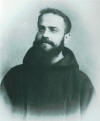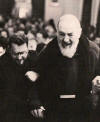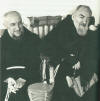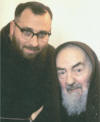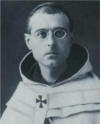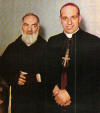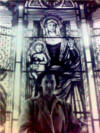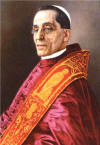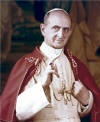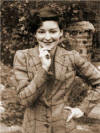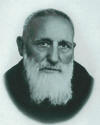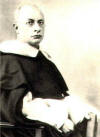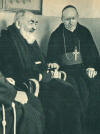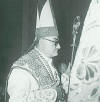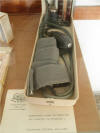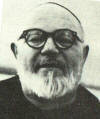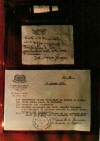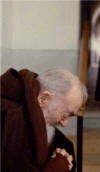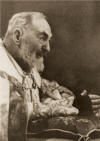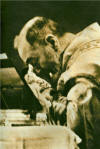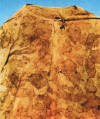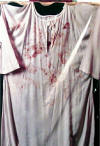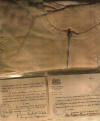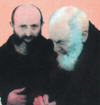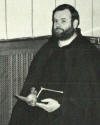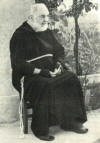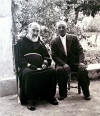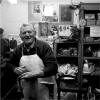22
Padre Pio's personality, health, fevers, eating, sleeping, discipline,
bloody garments
Padre Pio’s Personality
Summary: Personality; health; fevers; tears; eating; sleeping;
discipline.
Witnesses
Padre Lodovico da San Giovanni Rotondo: “He is kind and affable with
everyone; always smiling; sometimes he makes jokes, too.”[1]
Padre Pietro: He is candid, kind, charming, charitable, obedient,
modest, and pious.[2]
Padre Luigi D'Avellino
Padre Luigi: He is always indifferent before any honor. We have never
seen him abandon his simplicity.[3]
Padre Eusebio Notte
Padre Eusebio:” Padre Pio was a priest in whom God was particularly
alive.”[4]
“In Padre Pio the supernatural mixed with the natural in a way they you
were unable to distinguish were the first ended and the second started.”[5]
“Padre Pio was the man of two worlds: heaven and earth.”[6]
“People would go to him not only for confession but with every kind of
question you could imagine. And when he after confession had to go
upstairs, along the corridor were people after him with more questions.
And the same questions by different people got different answers.
He
never said “Let me think about it.”
He had the answer bing, bing, bing,
bing. If I should speak like that you would think that I am a madman.[7]
Padre Alessandro da Ripabottoni
Padre Alessandro: “Like the Morgione rock in Pietrelcina, Padre Pio had
an almost stubborn interior stability.”[8]
Padre Alessio Parente
Padre Alessio: “In San Giovanni Rotondo the extraordinary became
ordinary, and nobody paid much attention to it.”[9]
Don Giovanni Rossi: ‘Padre Pio was a man filled with the Holy Spirit.”[10]
Maria Winowska: Padre Pio had all the beautiful qualities of a southern
Italian, including a touch of humor that inspired in him immediate
answers and biting witticisms, flavored by peasant shrewdness.[11]
“Padre
Pio never stopped to say “Yes” to God.[12]
Clarice Bruno: “He gave all. All is of divine design.”[13]
Padre Raffaello Rossi, future Cardinal
Mons. Raffaello Rossi in 1921: “Whatever extraordinary happens in the
person of Padre Pio cannot be explained. But it certainly doesn’t happen
through diabolic intervention, deception or fraud.”[14]
“He has deeply felt profound humility, and outmost simplicity and
indifference, as if nothing had ever occurred around his person. He is
generally polite and respectful.
[15]
Mary Ingoldsby: “A masterpiece of God’s creative hand.”[16]
Mons. Paolo Carta
Bishop Paolo Carta: “He reached the summit of transforming union and
mystical experience.”[17]
Barbara Ward
Barbara Ward: “Padre Pio was the last man in the world to forget that
Our Lord not only preached to souls but also healed bodies and promised
Heaven to those that feed the hungry and clothe the naked.”[18]
Eileen Dunn Bertanzetti: “Despite all his afflictions of body and soul,
Padre Pio continued to trust Christ and to find great joy in God.”[19]
“Padre Pio was bargaining with God for souls”[20]
Dorothy Gaudiose: “His authenticity, originality, and genuineness were
indisputable, and the sincerity of his spirit was above suspicions.”[21]
Benedict XV
Pope Benedict XV in 1920: “Padre Pio is truly a man of God. He is not
appreciated by all, as he deserves to be.”[22]
[23]
Paul VI
Paul VI: “Padre Pio was a representative of Our Lord marked with the
imprint of his wounds. He was a man of prayer and suffering.”[24]
Dr. Bruno Pavone: “At the Casa Sollievo Padre Pio told continually the
nuns, the nurses, the doctors: “When you see the patient, look at Jesus
Christ. In every sick person, see Jesus suffering. In the sick poor see
Jesus twice, because Jesus was very poor.”[25]
Rev. Jean Derobert: "Padre Pio was the gleaming of God." (see related book)
Padre Lorenzo da San Marco in Lamis: “For the time he was at Montefusco
he was always exemplary. He was the most exemplary, not a grumbler.”[26]
Padre Lorenzo: “Padre Agostino and Padre Benedetto used to go to Padre
Pio for advice, and some friars would comment: “They went to consult the
saint in Mecca.”[31]
Padre Lorenzo: “His humility is remarkable. One cannot suppose the
existence in him of duplicity. He is very simple, so that he rather
needs direction an advice. He is a little prone to judging his
superiors.”[50]
Bill Martin, later Father Joseph Pius
Father Joseph Pius: “To encounter Padre Pio was likely reading medieval
history.”[27]
“We will never be finished with Padre Pio till the end of time.”[28]
Padre Saint John: “He had a nice chuckle and a nice smile. He was a
gentle person. He had a very dignified walk. He spoke a few English
words.”[29]
Padre Francesco Napolitano: “Padre Pio’s life on earth was in perpetual
union with God.”[30]
Padre Meyer: “The crowd would steal his handkerchief, cut pieces from
his habit and cut off his cord. He would not even notice it with all the
people pushing and pulling.”[32]
Sometimes Padre Pio took his cord and twirled it menacingly at people
grabbing him. He would say: “This is paganism! This is fanaticism!”[33]
Suzanne Marie Adele Beauclerk, Duchess of St. Albans
Suzanne Duchess of St. Alban: “The fascination of his gruff manner and
the magnetism of his extraordinary saintliness drew people to him, and
once they had met him, the experience marked them for life.”[34]
Heidi: “Being in San Giovanni Rotondo is like having a mirror up to your
face, but instead of showing your face, it reflects your soul.”[35]
Angelo Mischitelli: “A life between cell, choir, confessional, altar,
hallway and veranda.”[36]
Giovanni Bardazzi
Giovanni Bardazzi: “Padre Pio is goodness walking.”
(La bonta’ che cammina.)[37]
Padre Ignazio da jelsi
Padre Ignazio: One evening, joking with the friars, I made them try the
effects or veratridine when it is drawn close to the nose. Padre Pio
too, took some, and he had to go back to his cell because he couldn’t
stop sneezing.[38]
Mary Bridget Nolan: “It doesn’t happen every day to hear about Angels
smiling, crying, driving cars, involved in human events.”[39]
Dorothy Valls: “Padre Pio had such knowledge of the human soul that
Freud could learn from him.”
[40]
Padre Alberto D'Apolito
Padre Alberto: “So many people tell me that Padre Pio is a supernatural
being. He is like Christ reincarnated sent by God to stem the evil of
people.”[41]
Padre Atanasio Lonardo: “He was a real builder of God’s kingdom on
earth.”[43]
Padre Innocenzo Santoro: “Padre Pio never refused anyone, anything. All
one had to do was ask.”[44]
Padre Giovanni da Baggio: “Padre Pio had the ingenuous candor of a
little child, and he opened his heart with great affection to those who
approached him in a frank and sincere spirit.”[45]
Padre Cherubino: “Padre Pio is very simple, and for this reason he
rather needs direction and advice from those around him.”[46]
Padre Marcellino Iasenzaniro
Padre Marcellino: “We will only really know Padre Pio in Heaven.”[47]
Padre Calogero Peri: “It is difficult for me to understand God’s plan on
Padre Pio, whose saintliness has been opposed and exalted as in few
cases in the history of the Church.”[48]
Padre Romolo: “In my opinion Padre Pio is informal, like a child who
would need clear and definite orders in all the areas of his behavior.”[49]
Padre Giocondo Lorgna
Venerable Giocondo Lorgna: “Padre Pio is the most affable, cordial,
angelic, obedient. He has healed others and he is always ill.”[51]
Mons. Adolfo Tortolo
Archbishop Adolfo Tortolo: “Padre Pio moved the world and continues[52]
to move it.”
Archbishop Andrea Cesarano: “I saw Padre Pio in 1933 when he was in
complete seclusion. He was calm, serene, cheerful, and fully obedient to
the orders.”[53]
Padre Donato da Welle, Minister general
Padre Donato da Welle: “Padre Pio is a great saint.”[54]
Jim Gallagher (at the end of the Biography of Padre Pio that he wrote):
“Now I understand what the gospel writer John felt when he wrote: There
are many other things that Jesus did. It they were all written down, one
by one, I suppose that the whole world could not hold the books that
would be written.”[55]
Mons. Raffaele Pellecchia, Archbishop of Sorrento and Castellammare di
Stabia: “The glorification of Padre Pio is the clearest answer that the
Church of the Ecumenical Council gives to the modern age, because the
joys and the hopes, the sadness and anguishes of humankind today,
especially of the poor and of people suffering, were also his joys and
hopes, sadness and anguishes. And anything that was genuinely
human echoed in his heart.[56]
Health
Padre Rosario da Aliminusa: “Padre Pio always seemed to be at the
extreme limits of his strength, and perpetually at the point of death.”[57]
Rev. Bernard Ruffin: Since childhood Padre was plagued by ill-defined
physical problems. He suffered from intestinal irritability, inability
to retain solid food for weeks and months on end, spasms of violent
coughing, excruciating headaches, and unusually high temperatures. Some
days he would seem to be reduced to the point of death, only to recover
just as suddenly. In 1908 in Montefusco a doctor made the devastating
diagnosis of pulmonary tuberculosis, and he had to be sent home to
prevent contagion. At home, Dr. Andrea Cardone refused to give that
diagnosis, and suggested to see a specialist in Naples. In Naples the
doctors were not able to say what the matter was. He went back to
Montefusco, but he was soon seized by violent stomach cramps and
persistent vomiting, and had to be sent home again. Each time he
returned home he improved. He could not remain a single day at any
friary without suffering a relapse. Padre Benedetto obtained for him a
dispensation to live at home, with the Capuchin habit, and complete his
studies privately. But he started feeling ill even in Pietrelcina. In
March of 1910 he had continuous fevers, cough, pain in the chest and
back. In April he was confined to bed. In May he had chest pains. In
July the pains increased.[58]
Mons. Raffaello Rossi: “For his studies he went from convent to convent,
however, many times the state of his health forced him to go back
breathing his native air. He was said to suffer from bronchial
pneumonia; in reality, the medical exams never confirmed this
positively.”[59]
Padre Luigi: “What I saw is that at times he would fall ill very once in a while, and sweat in an extraordinary
manner.”[60]
“Padre Pio fell seriously ill on the feast of the Immaculate in
1919, and in May 5, 1920. We thought he was going to die; the rumor had
spread that he would die at thirty-three, the age he was about to turn
then. Instead, he healed and got better.”[61]
Padre Nazareno in his notes in 1916, when Padre Pio was in Foggia, in
St. Anna’s convent: “He got a bad fever of 41C (105.8F) degrees and
higher. I called Dr. Del Prete, he found infiltration in both apexes and
ordered complete isolation. Dr. Tarallo was called for consultation and
he diagnosed the same thing. Both doctors would come every evening to
visit Padre Pio. They were puzzled and said this must have been a
special disorder, coming and going. The fever stayed for several days
and then suddenly disappeared, with great confusion of the doctors. In
summary both doctors said that he didn’t have tuberculosis. The same
conclusion had been reached by Dr. Cardona in Pietrelcina.”
[62]
[63]
[64]
Padre Marciano Morra: Prof. V. Ewans from London told Padre Carmelo, at
a conference in “Casa Sollievo” on May 15, 1956: “For us doctors Padre
Pio is biologically dead. A human being can’t work so long hours, and
lose so much blood, without adequate food, rest, and vacation time.
According to the scientific principles of the basic needs for survival,
Padre Pio is biologically dead.”[65]
Fevers
In the old days the body temperature was taken by mercury thermometer,
today no longer in common use. Normal body temperature is 98.2°F (or
36.8°C). A temperature at or above about 104 °F (40 °C) requires
treatment.
Padre Pio had long bouts of high fevers, inexplicable mystical fevers,
followed by normal temperatures.[66]
Padre Pio himself said that at times his temperature rose to 118.4. He
said; “that happens when I am ill. But the illness is a moral, rather
than a physical, illness"[67]
and said it happened when he had “some representation of the Lord”, and
seemed like he was "in a furnace, still always conscious".[68]
A friar attested that "even under the strain of this fever, Padre Pio is
not knocked down, but gets up, moves about, and can do everything."[69]
It is baffling that no delirium or other mental disturbances accompanied
such high temperatures.[70]
In the military hospital he continued to suffer fevers with
extraordinarily high temperatures. A thing which he and his colleagues
in religion had become used to,
But which were completely new to the medical and nursing staff.[71]
On December 1915 at the Trinity Military Hospital in Naples, during the
routine physical, Padre Pio's temperature was taken by Dr. Giuseppe
Grieco, lieutenant medical doctor in the Italian Army, with an armpit
mercury thermometer. In less than one minute the thermometer cracked,
having gone over the maximum temperature of 42C (107.6). Three other
thermometers cracked the same way. Dr. Grieco called in a colleague dr.
Francesco Melle.
They decided to try with a bath thermometer, removed from the casing
that could read up to 80C (176F). The thermometer read 48C (118.4).
They couldn't believe it, so they tried with a laboratory precision
thermometer. This time the temperature was 49C (120.2).
They decided to inform the captain prof. Dr. Felice D'Onofrio, chief of
medical services. He came in, measured again, and the reading was 49C.
"This is a mystery. This is impossible. I can't believe my eyes. He
should be in agony. This man is either a saint or a devil." He
prescribed quinine and went to see him in the morning. He took again the
temperature and was 36.7C (98.06). "I don't understand anything. Let's
send him home to die in peace."
[72]
[73]
Dr. Giorgio Festa in 1920 took Padre Pio's temperature as part of his
investigation. The reading was 48.5C.
Padre Alberto D’Apolito reported that in 1920 “I would take Padre Pio’s
temperature several times and it would register between 46C and 47C
(114,8F – 116,6F).[74]
In 1921 Padre Lorenzo, superior of the convent, testified under oath to
Mons. Rossi that he was skeptical, and had personally witnessed and
recorded Padre Pio with fevers of 43C (109.4F) degrees Fahrenheit, then
45C (113F) degrees, and finally 48C (118.4F) degrees.[75]
[76]
San Giovanni Rotondo, February 8, 1917:
“I have been sick of pneumonia,
with very high fevers.”[77]
The two thermometers used by Padre Paolino da Casacalenda, with a certificate of authenticity.
The fevers were over 42C, the maximum reached by a normal thermometer, because the thermometers cracked when used on Padre Pio. During a similar episode, on January 27 1917, the superior of the convent, Padre Paolino da Casacalenda, decided to take Padre Pio’s temperature personally. The mercury climbed to 108F degrees, than broke the bulb of the thermometer. Padre Paolino hurried to the bathroom and fetched a bath thermometer, freed it from the wooden sheath, and placed it under Pio’s armpit. The temperature soared to
125.5F degrees.[78]
Padre Paolino da Casacalenda
“When I removed the thermometer from the armpit it had reached 52C.
Fifty two degrees! Well, I looked at Padre Pio. He didn’t seem in bad
shape. I put a hand on his forehead. It was not hat. The color was of
somebody who has no fever.”[79]
[80]
Dr. Giuseppe Avenia reported in a written testimony that in about 1941 he was at Padre Pio's bedside with Padre Damaso, the superior, and Padre Ezechia. He put the thermometer under Padre Pio's armpit and in few seconds the mercury reached the top of the scale and the bulb broke.
Padre Dominic Meyer, from Belleville, Illinois was sent in 1947 to the
Convent to take care of the more than 250 letters Padre Pio received
daily in English and German. He did it for the next thirteen years. He
described in September 1949 a bout with "sister fever" in which Padre
Pio's temperature was measured by dr. Sanguinetti with a special
thermometer as 114F degrees.
Tears
Padre Pellegrino: “When Padre Pio prepared himself for confession, he
invoked Our Lady and wept. He cried so many tears that with these alone
he could have cancelled all of his sins. Once, he was crying and I told
him about it. He said: “So now to cry for my sins I need to ask your
permission?”[81]
Padre Eusebio was confessing Padre Pio. When he had finished confessing
his sins he burst in tears. Padre Eusebio: “I can’t see any proportion
between the sins you have confessed and your display of such pain and
sorrow.” Padre Pio: “Son, I am the biggest sinner on this earth!” And he
continued to cry sorrowfully.[82]
Padre Antonino testified: “In Sant’Elia a Pianisi, at the time of the
common prayers, and especially after Communion, brother Pio shed so many
tears that made a little pit in the pavement. We asked him for the
reason, and he never told us. One day, since I was his spiritual
director, I asked him under obedience, and he said: “I cry for my sins,
and the sins of everybody.”[83]
Brother Leo (Fra' Leone) classmate of Padre Pio 1903-8, testified:
"While praying, Padre Pio was always crying, silently, and so abundantly
that his tears were leaving traces on the stone pavement of the choir.
We youngsters made fun of him. So he took the habit of lying on the
floor hi large handkerchief in front of him.
After praying he would take the handkerchief that was all wet. You could
have squeezed it!"[84]
[85]
[86]
Padre Damaso da Sant’Elia a Pianisi gave a similar testimony.[87] Padre Antonio da San Giovanni Rotondo,
reported the same, and when he asked Brother Pio why he was crying, the answer was: “I cry for my sins and
those of mankind.”[88]
Padre Placido did the novitiate with Padre Pio in 1902. All the novices
had an assigns stall for meditation. They noticed that while meditating,
fra’ Pio cried abundantly. One day he and the other novices jokingly
asked future Padre Pio: “Why is your place in the choir always wet and
ours dry?” Padre Placido reported that from that day on fra’ Pio spread
out his large handkerchief on the floor in front to him and it was
always soaked with tears.[89]
Dr. Franco Lotti found Padre Pio crying in his room. He asked why he was
shedding those tears. “I am crying at the thought of when I will have to
be in God’s presence.”[90]
He used to say: "Good works are the fruit of many tears and of a lot of
suffering."
Francesco Napolitano: “Padre Pio never failed to cry when he celebrated
the Divine Sacrifice.”[91]
“I have committed so many sins! Think that from birth, on May 25, 1887
until vestition, on January 23 1903, I never thanked the Lord for
having been baptized so soon, just fourteen hours after birth, at 8:00
AM of May 26. I am an ungrateful wretch.
“And he continued crying.[92]
Eating
To eat very little was a constant in Padre Pio’s life.[93]
Padre Roberto da Nove: Padre Pio eats nothing for breakfast or dinner.
Lunch: boiled vegetables, fruit of season, sometimes an egg.[94]
Sometimes he has a hot chocolate for dinner.[95]
There are periods when he can’t keep anything down: moments when
he takes to some food, which later he cannot tolerate.[96]
Many evenings he doesn’t eat anything at all.[97]
Padre Romolo da San Marco in Lamis: “He doesn’t eat much. He eats rather
sparingly. He eats just a little bit of everything. He eats more or less
a third of what I eat.”[98]
[99]
Padre Pio to his nephew Mario Pennelli: “In forty years I have not been
able to eat even half of a loaf of bread.”[100]
[101]
Padre Alberto: “Padre Pio had some very hard biscuits and roasted chick
peas in the pantry drawer. Instead of the food brought to him he would
put one of those in his mouth, and chew very slowly, giving everyone the
impression that he was eating.”
It was truly amazing how he could bear up in the confessional for so
many hours without adequate nourishment.”[102]
[103]
Dr. Pavone. “Padre Pio ate very little. He used to go once a day to the
refectory under obedience. In medical terms the nourishment of Padre Pio
was absolutely insufficient. These things are against the natural law;
against everything. But they happened.”[104]
Fra’ Modestino: “Padre Pio ate very little. Some days he ate nothing at
all.
On a Christmas day he took an espresso coffee. He said: “It’s Christmas
and it’s time to celebrate. Once in a while he enjoyed a slice of pork
liver, or artichokes or turnips sent from Pietrelcina”[105]
One day Padre Pio told
Fra’ Modestino: “The greatest favor I could get from the superior would
be to dispense me from eating.”[106]
[107]
Padre Dominic Meyer: “He also ate macaroni, cheese, peas, beans, fruit,
liver, fried sausage, dried ham, and as all good Italians, he drank a
glass of wine. But everything was eaten in minute quantities. Frequently
he handed much of the food that was served to him to the friar next to
him.[108]
Every doctor who observed him eating stated that what he ate was
insufficient to keep an adult alive.[109]
Padre Pio said that he was nourished by the sole Eucharist: “It is the Lord who does this and not I. It is the Lord
who is working in me.”[110]
Padre Nazareno d’Arpaise: “In Foggia Padre Pio was prepared
special meals. He would just taste the food and then pass it to
other friars. I asked him: “Piuccio haven’t you tuberculosis?” “Yes?”
“Why then you give your food to other friars? Don’t you know that your
disease is highly contagious? ““Yes, but my disease, by special
disposition of the Lord, is not contagious.”[111]
[112]

 It seems that Padre Pio's favorite food was
broccoli rabe, but he had very few opportunities to eat them.
It seems that Padre Pio's favorite food was
broccoli rabe, but he had very few opportunities to eat them.
Sleeping
Padre Pio slept with just a sheet and a light plaid, as he couldn’t
stand heavy blankets.[113]
Padre Pio asked a young man how long he had slept the previous night. “Six or seven.” Padre Pio replied:
“That’s as much I sleep in one year.”[114]
Padre Pio: “I have great distress in meeting the daily needs of eating,
drinking, and sleeping. I do it only because the Lord wants it.”[115]
Padre Raffaele: “In his early priestly life he would get up at 3:00 in
the morning. In his later
years, generally he would not go to bed at all. When he would go to bed
he would put the alarm at three o’ clock. He would only sleep for about
three hours at most.”[116]
Padre Eusebio: “He would get up very early in the morning, clean his
wounds and start to say the rosary and pray and meditate.”[117]
Typical day of Padre Pio
Padre Roberto da Nove, testified in 1920: “Padre Pio gets up at the same
time of the community 5:30 AM. He hears confessions until 10:00 AM, when
he celebrates Holy Mass. After Mass, he returns to his cell for the
thanksgiving prayer. He then goes down to the sacristy to listen to all
those who wish to talk to him and be blessed. They are many and come
from all the regions of Italy and from abroad. It takes great patience
to listen to so many miseries and to welcome so many sick and desperate
souls, who ask for help, confidence, faith, peace.
At noon he has lunch in the refectory of the small minor seminary
of which he is the spiritual director. His menu consists of boiled
vegetables, fruit (when in season), with sometimes an egg. And this is
all he eats in one day, since neither in the morning nor in the evening
does he take anything else. In the evening he stays a while to converse
with the community.”[118]
Padre Raffaele: In his early priestly life he would get up at 3:00 in
the morning. He would celebrate Mass whenever his superiors would tell
him. Many times his superior had to call him out of the confessional to
go to the refectory. Otherwise he would be hearing confessions all the
time. He ate only a little. He would just take a nibble. Then, he would
hear confessions until the Angelus at 6:00 pm. He never came to supper
in the evening. In his later years, generally he would not go to bed at
all. After the earthquake of 1939 he slept in an ambulance parked in the
friary garden for almost a month.
[119]
Discipline
When he was ten years old Francesco started scourging himself with an
iron chain , "to
imitate Jesus, who had been beaten by the Jews."
[120]
Druing the year of novitiate in Morcone, on Mondays, Wednesdays, and
Fridays the community took the discipline. The friars and novices went
to the choir, pulled the habit from their backs and struck themselves on
the bare flesh with a chain. During the discipline they were to think of
the Passion of Jesus.
[121]
There was always blood on the floor after these religious
exercises.[122]
In Pietrelcina Padre Pio continued to observe the “discipline” on the
customary days, striking himself with a metal chain until the blood run.[123]
Padre Pio used brown fingerless gloves over the wounds of the hands during the day At night he used white gloves
Ecce Homo!
Bloody undershirt from scourging
Cleonice Morcaldi wrote: “It was summertime and Padre Pio, all dressed in wool, was
suffering terribly the heat. I sent him a white light linen undershirt
to be used instead of the woolen one. I was pretty sure the he would
refuse it. Instead, a got it back after three days; it was all bloody.
Literally speaking, there was no space in between the stains of blood.
In several areas, especially over the shoulders, there were stain over
stain. I had also sent a pair of white sox. They too had big stains over
the area of the wound. A Franciscan friar took these sacred relics to be
kept in the archives. A priest took a picture. He then passed it to a
journalist without my permission. God allowed it, because it did so much
good to those who saw it.”[108]
On January 17, 1969, the superior of the convent, Padre Pellegrino, gave
to Fra’ Modestino the assignment to do the inventory of the items
related to Padre Pio.
He reported: “I found an enormous quantity of cloths used for the side
wound. Each of them had a date on it. Among many other things I found an
undershirt full of blood stains. There was a statement attached, naming
it “the undershirts of the scourging on Good Friday 1921. It was a knee
length undershirt. Now I understood the terrifying sufferings that Padre Pio had been going through. And the scourging happened almost every
week.”[67]
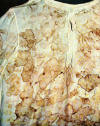
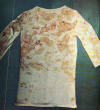 Undershirt removed on
January 1943
Undershirt removed on
January 1943
 Cloths wiping bloody front sweat in March of 1941
Cloths wiping bloody front sweat in March of 1941
Bloody right shoulder
Padre Pio's undershirt with blood in the right shoulder area found and certified by Fra' Modestino.
Before, little was known about the shoulder wound, related to Jesus carrying the Cross to the Calvary, in the Passion.
Fra' Modestino:
“On February 4, 1971, observing again a woolen undershirt, I noted to my
great surprise, a stain of blood, of about four inches, over the right
shoulder. Jesus had been carrying a heavy cross. I had to find this out.
Before going to bed I prayed Padre Pio asking if he really had a sore on
the right shoulder. I woke up around 1:00 AM and felt a terrible pain on
my right shoulder at it had been penetrated by a knife. At the same time
I smelled a strong perfume, and heard a voice: “that’s the way I have
suffered!” Now I had understood!”[68]
Fra’ Modestino died on August 14, 2011. His body rests in the church of
Holy Family and Padre Pio in Pietrelcina.
Permanently swollen feet
Bill Martin Joseph Pius
Father Joseph Pius, Brooklyn born Bill Martin, helped Padre Pio for several years. He stated: "His feet were always swolle, very swollen. They were like melons under his socks." (Sch87, 63)

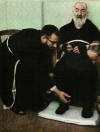 Helped by Padre Alessio and Mr. Zeni
Helped by Padre Alessio and Mr. Zeni
 Basin used by Padre Pio for his feet
Basin used by Padre Pio for his feet
Sandals for painfully swollen feet. Note the swollen feet, even with special custom sandals.
Matteo Biancofiore, shoemaker
Matteo Biancofiore was the shoemaker who made the sandals for Padre Pio. Born in Foggia, moved to San Giovanni Rotondo. His excellent skills made padre Pio's walking less painful. The idea of making custom sandals for Padre Pio was suggested to Matteo by Mons. Salvatore Novelli, an uncle on maternal side. A tender friendship developed between Padre Pio and Matteo Biancofiore. Padre Pio administered the First Communion to all of Matteo's eight children. Matteo died in 1998 at the age of 103.
Grooming

 Haircut by Vincenzo Miniscalchi.
Haircut by Vincenzo Miniscalchi.
 Padre Alessio tinkering with Padre Pio's beard.
Padre Alessio tinkering with Padre Pio's beard.
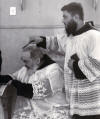 Final touch before the evening function in church.
Final touch before the evening function in church.
Bibliography
Alberto,
D'Apolito (2007). Padre Pio of Pietrelcina. Memories. Experiences.
Testimonials. San Giovanni Rotondo: Edizioni Padre Pio. Alb07
Alessando, d. R. (Saint Pio of Pietrelcina. Everybody's Cyrenean).
2010. San Giovanni Rotondo: Edizioni Padre Pio. Ale10
Allegri, R. (2000). La vita e i miracoli di Padre Pio. Milano:
Oscar Mondadori. All00
Capuano, P. (2012). Con p. Pio: come in una fiaba. Foggia:
Grafiche Grilli. Cap12
Casacalenda, P. P. (1978). Le mie memorie intorno a Padre Pio.
San Giovanni Rotondo: Edizioni Padre Pio. Cas78
Castelli, F. (2011). Padre Pio under investigation. The secret
Vatican files. San Francisco: Ignatius Press. Cas11
Cataneo, P. (1991). Padre Pio gleanings. Editions Paulines
Quebec. Cat91
Chiron, Y. (1999). Padre Pio. Una strada di misericordia. Milano:
Figlie di San Paolo. Chi99
Clarice, Bruno (1970). Roads to Padre Pio. Roma: Citta' Nuova.
Bru70
Convento. (2001). Padre Pio dalla Terra al Cielo. San Giovanni
Rotondo: Edizioni Frati Cappuccini. Con01
Covino, P. P. (2007). Ricordi e testimonianze. San Giovanni
Rotondo: Edizioni Padre Pio. Cov07
DeLiso, O. (1962). Padre Pio. New York: All Saints Press. DeL62
Duchess Suzanne, o. S. (1983). Magic of a Mistic. Stories of Padre
Pio. New York: Clarkson N. Potter. Duc83
Dunn Bertanzetti, E. (1999). Padre Pio's Words of Hope.
Huntington, Indiana: Our Sunday Visitor, Inc. Dunn99
Flumeri, G. D. (1995). Le stigmate di Padre Pio, Testimonianze e
relazioni. Edizioni Padre Pio. Flu95
Gallagher, J. (1995). Padre Pio, The pierced priest. London:
HarperCollins. Gal95
Gaudiose, D. M. (1974). Prophet of the people. A biography of Padre
Pio. New York: Alba House. Gau74
Giannuzzo, E. (2012). San Pio da Pietrelcina. Il travagliato persorso
della sua vita terrena. Book sprint edizioni. Gia12
Iasenzeniro, F. M. (2006). The "Padre" saint Pio of Pietrelcina. His
mission to save souls. Testimonies. San Giovanni Rotondo: Edizioni
Padre Pio.Ias06
Ingoldsby, M. (1978). Padre Pio. His Life and Mission. Dublin:
Veritas Publications.Ing78
Keane, C. (2007). Padre Pio The Irish Connection. Edinburg:
Mainstream Publishing. Kea07
Malatesta, E. (1999). La vera storia di Padre Pio. Casale
Monferrato: PIEMME. Mal99
McCaffery, J. (1978). Tales of Padre Pio. Kansas City: Andrews
and McMeel. McC78
Modestino, F. d. (2001). Io testimone del Padre. San Giovanni
Rotondo: Edizioni Padre Pio. Mod01
Morcaldi, Cleonice (1997). LA MIA VITA VICINO A PADRE PIO Diario
intimo spirituale. Roma: Edizioni Dehoniane. Cle97
Mortimer Carty, f. C. (1973). Padre Pio the stigmatist. TAN
Books. Mor73
Napolitano, F. (1978). Padre Pio of Pietrelcina. A brief biography.
San Giovanni Rotondo: Edizioni Padre Pio. Nap78
Padre, Pio d. (2010). Have a good day. San Giovanni Rotondo:
Edizioni Padre Pio. Pio10
Parente, A. (2011). Padre Pio e le anime del purgatorio. San
Giovanni Rotondo: Edizioni Padre Pio. Par011
Parente, F. A. (2011). Mandami il tuo angelo custode. San
Giovanni Rotondo: Edizioni Padre Pio. Par11
Pietrelcina, P. P. (2011). Epistolario I, Corrispondenza con i
direttori spirituali (1910-1922), a cura di Melchiorre da Pobladura e
Alessandro da Ripabottoni, IV edizione. San Giovanni Rotondo:
Edizioni Padre Pio da Pietrelcina. Epist. I
Pietrelcina, P. P. (2012). Epistolario IV, corrispondenza con diverse
categorie di persone. San Giovanni Rotondo: Edizioni Padre Pio.
Epist. IV
Ruffin, C. B. (1991). Padre Pio: the true story. Huntington,
Indiana: Our Sunday Visitor, Inc. Ruf91
Schug, J. O. (1987). A Padre Pio Profile. Petersham, MA: St.
Bedès Publications. Sch8u7
Winowska, M. (1988). Il vero volto di Padre Pio. Milano: Edizioni
San Paolo. Win88
[1] Cas11, 192
[2] Cas11, 91
[3] Cas11, 174
[4] SCH87, 122
[5] Par011, 127
[6] For99, 11
[7] Sch87, 118-122
[8] Ale12, 5
[9] Par11, 37
[10] Bru70, 224
[11] Win88, 57
[12] Win88, 178
[13] Bru70, 226
[14] Cas11, 132
[15] Cas11, 95
[16] Ing78, xiii
[17] Ing78, 41
[18] Mor73, xvii Introduction
[19] Dun99, 12
[20] Ing78, 104
[21] Gau73, X
[22] Del62, 78
[23] Win03, 153
[24] Ing78, 146
[25] Sch87, 35
[26] Cas11, 151
[27] Scg87, 74
[28] Sch87, 79
[29] Ruf91, 262-3
[30] Nap76, 51
[31] Cas11, 152
[32] Ruf91, 293
[33] Ruf91, 293
[34] Duc83, ix
[35] Duc83, 163
[36] Ale11, 30
[37] McC78, 28
[38] Cas11, 168
[39] Ale11, 34
[40] Sch87, 143
[41] Sch87, 49
[42] Cas11, 170
[43] Ias07, 605
[44] Ias07, 605
[45] Mul09, 118
[46] Cas11, 198
[47] Ias07, 592
[48] Ias07, 594
[49] Cas11, 185
[50] Cas11, 158
[51] Cas11, 63-4
[52] Ale010, 362
[53] Cam11, 56
[54] Ger95, 129
[55] Gal 95, 228
[56] Per02, 542
[57] Nap76, 99
[58] Ruf91, 71 ss.
[59] Cas11,10
[60] Cas11, 172
[61] Cas11, 176
[62] Chi67, I, 84-90
[63] Gia12, 97
[64] Chi99, 89-90
[65] Mor06, 243-4
[66] Mal99, 49
[67] Cas11, 127
[68] Cas11, 127
[69] Cas11, 127
[70] Pas91, 29
[71] Gal95, 73
[72] All00, 178-84
[73] Cap12, 168
[74] Alb07, 69
[75] Cas11, 126-7
[76] Cas11, 153
[77] Epist I, 866
[78] Ruf91, 134
[79] Pao78, 86
[80] Chi99, 100
[81] Ias06, 43
[82] Ias06, 44
[83] Ale74, 32
[84] Win88, 134-5
[85] Ing75, 24
[86] Positio III/1, 50
[87] Ale10, 33
[88] Ale10, 33
[89] Cap06, 136-7
[90] Ias06, 42
[91] Nap76, 53
[92] Win 88, 174
[93] Cas11, 69
[94] Cas11, 69
[95] Cas11, 88
[96] Cas11, 89
[97] Cas11, 175
[98] Cas11, 88
[99] Cas11, 182
[100] Cas11, 69
[101] Gal09, 46
[102] Cas11, 88
[103] Alb07, 100
[104] Sch87, 34-5
[105] Mod01, 29-30, 32 , 50-1
[106] Mod01, 30
[107]
Positio II, 147
[108] Ruf91, 289
[109] Ruf91, 289
[110] Ruf91, 290
[111] Gia12, 97
[112] Chi99, 89
[113] Ias06, 323
[114] Sch87, 35
[115] Epist. I, 107
[116] Sch87, 98
[117] Sch87, 120
[118] Cas11, 68-9
[119] Sch87, 97-100
[120] Positio I,1, 606
[121] Ruf91, 51
[122] Duc83, 36
[123] Ruf91, 97
[124] Flu95, 136
